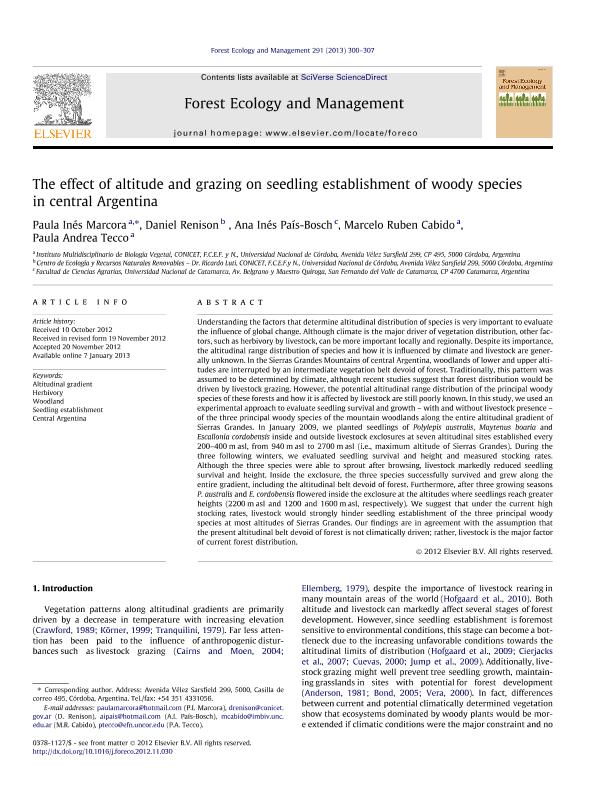Mostrar el registro sencillo del ítem
dc.contributor.author
Marcora, Paula Inés

dc.contributor.author
Renison, Daniel

dc.contributor.author
Pais Bosch, Ana Ines

dc.contributor.author
Cabido, Marcelo Ruben

dc.contributor.author
Tecco, Paula Andrea

dc.date.available
2017-02-03T18:20:59Z
dc.date.issued
2013-03
dc.identifier.citation
Marcora, Paula Inés; Renison, Daniel; Pais Bosch, Ana Ines; Cabido, Marcelo Ruben; Tecco, Paula Andrea; The effect of altitude and grazing on seedling establishment of woody species in central Argentina; Elsevier Science; Forest Ecology And Management; 291; 3-2013; 300-307
dc.identifier.issn
0378-1127
dc.identifier.uri
http://hdl.handle.net/11336/12447
dc.description.abstract
Understanding the factors that determine altitudinal distribution of species is very important to evaluate the influence of global change. Although climate is the major driver of vegetation distribution, other factors, such as herbivory by livestock, can be more important locally and regionally. Despite its importance, the altitudinal range distribution of species and how it is influenced by climate and livestock are generally unknown. In the Sierras Grandes Mountains of central Argentina, woodlands of lower and upper altitudes are interrupted by an intermediate vegetation belt devoid of forest. Traditionally, this pattern was assumed to be determined by climate, although recent studies suggest that forest distribution would be driven by livestock grazing. However, the potential altitudinal range distribution of the principal woody species of these forests and how it is affected by livestock are still poorly known. In this study, we used an experimental approach to evaluate seedling survival and growth – with and without livestock presence – of the three principal woody species of the mountain woodlands along the entire altitudinal gradient of Sierras Grandes. In January 2009, we planted seedlings of Polylepis australis, Maytenus boaria and Escallonia cordobensis inside and outside livestock exclosures at seven altitudinal sites established every 200–400 m asl, from 940 m asl to 2700 m asl (i.e., maximum altitude of Sierras Grandes). During the three following winters, we evaluated seedling survival and height and measured stocking rates. Although the three species were able to sprout after browsing, livestock markedly reduced seedling survival and height. Inside the exclosure, the three species successfully survived and grew along the entire gradient, including the altitudinal belt devoid of forest. Furthermore, after three growing seasons P. australis and E. cordobensis flowered inside the exclosure at the altitudes where seedlings reach greater heights (2200 m asl and 1200 and 1600 m asl, respectively). We suggest that under the current high stocking rates, livestock would strongly hinder seedling establishment of the three principal woody species at most altitudes of Sierras Grandes. Our findings are in agreement with the assumption that the present altitudinal belt devoid of forest is not climatically driven; rather, livestock is the major factor of current forest distribution.
dc.format
application/pdf
dc.language.iso
eng
dc.publisher
Elsevier Science

dc.rights
info:eu-repo/semantics/openAccess
dc.rights.uri
https://creativecommons.org/licenses/by-nc-nd/2.5/ar/
dc.subject
Altitudinal Gradient
dc.subject
Herbivory
dc.subject
Woodland
dc.subject
Seedling Establishment
dc.subject
Central Argentina
dc.subject.classification
Ecología

dc.subject.classification
Ciencias Biológicas

dc.subject.classification
CIENCIAS NATURALES Y EXACTAS

dc.title
The effect of altitude and grazing on seedling establishment of woody species in central Argentina
dc.type
info:eu-repo/semantics/article
dc.type
info:ar-repo/semantics/artículo
dc.type
info:eu-repo/semantics/publishedVersion
dc.date.updated
2017-01-31T17:49:36Z
dc.journal.volume
291
dc.journal.pagination
300-307
dc.journal.pais
Países Bajos

dc.journal.ciudad
Amsterdam
dc.description.fil
Fil: Marcora, Paula Inés. Consejo Nacional de Investigaciones Científicas y Técnicas. Centro Científico Tecnológico Córdoba. Instituto Multidisciplinario de Biología Vegetal (p); Argentina
dc.description.fil
Fil: Renison, Daniel. Universidad Nacional de Córdoba. Facultad de Ciencias Exactas, Físicas y Naturales. Centro de Ecología y Recursos Naturales Renovables; Argentina. Consejo Nacional de Investigaciones Científicas y Técnicas; Argentina
dc.description.fil
Fil: Pais Bosch, Ana Ines. Consejo Nacional de Investigaciones Científicas y Técnicas; Argentina. Universidad Nacional de Catamarca; Argentina
dc.description.fil
Fil: Cabido, Marcelo Ruben. Consejo Nacional de Investigaciones Científicas y Técnicas. Centro Científico Tecnológico Córdoba. Instituto Multidisciplinario de Biología Vegetal (p); Argentina
dc.description.fil
Fil: Tecco, Paula Andrea. Consejo Nacional de Investigaciones Científicas y Técnicas. Centro Científico Tecnológico Córdoba. Instituto Multidisciplinario de Biología Vegetal (p); Argentina
dc.journal.title
Forest Ecology And Management

dc.relation.alternativeid
info:eu-repo/semantics/altIdentifier/url/http://www.sciencedirect.com/science/article/pii/S0378112712007062
dc.relation.alternativeid
info:eu-repo/semantics/altIdentifier/doi/http://dx.doi.org/10.1016/j.foreco.2012.11.030
Archivos asociados
